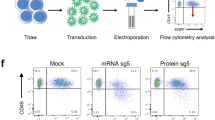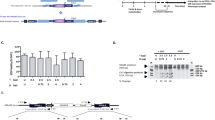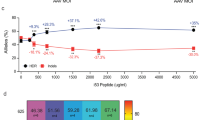Abstract
Directed gene therapy mediated by nucleases has become a new alternative to lead targeted integration of therapeutic genes in specific regions in the genome. In this work, we have compared the efficiency of two nuclease types, TALEN and meganucleases (MN), to introduce an EGFP reporter gene in a specific site in a safe harbor locus on chromosome 21 in an intergenic region, named here SH6. The efficiency of targeted integration mediated by SH6v5-MN and SH6-TALEN in HEK-293H cells was up to 16.3 and 15.0%. A stable expression was observed both in the pool of transfected cells and in established pseudoclones, with no detection of off-target integrations by Southern blot. In human hematopoietic stem and progenitor CD34+ cells, the nucleofection process preserved the viability and clonogenic capacity of nucleofected cells, reaching up to 3.1% of specific integration of the transgene in colony forming cells when the SH6-TALEN was used, although no expression of the transgene could be found in these cells. Our results show the possibility to specifically integrate genes at the SH6 locus in CD34+ progenitor cells, although further improvements in the efficacy of the procedure are required before this approach could be used for the gene editing of hematopoietic stem cells in patients with hematopoietic diseases.
This is a preview of subscription content, access via your institution
Access options
Subscribe to this journal
Receive 12 print issues and online access
$259.00 per year
only $21.58 per issue
Buy this article
- Purchase on Springer Link
- Instant access to full article PDF
Prices may be subject to local taxes which are calculated during checkout







Similar content being viewed by others
References
Kaufmann KB, Buning H, Galy A, Schambach A, Grez M. Gene therapy on the move. EMBO Mol Med. 2013;5:1642–61.
Ghosh S, Thrasher AJ, Gaspar HB. Gene therapy for monogenic disorders of the bone marrow. Br J Haematol. 2015;171:155–70.
Shen H, Zhong X, Zhao F, Wang Y, Yan B, Li Q, et al. Overexpression of receptor-like kinase ERECTA improves thermotolerance in rice and tomato. Nat Biotechnol. 2015;33:996–1003.
Ciccia A, Elledge SJ. The DNA damage response: making it safe to play with knives. Mol Cell. 2010;40:179–204.
Jensen NM, Dalsgaard T, Jakobsen M, Nielsen RR, Sorensen CB, Bolund L, et al. An update on targeted gene repair in mammalian cells: methods and mechanisms. J Biomed Sci. 2011;18:10.
LaFountaine JS, Fathe K, Smyth HD. Delivery and therapeutic applications of gene editing technologies ZFNs, TALENs, and CRISPR/Cas9. Int J Pharm. 2015;494:180–94.
Naldini L. Ex vivo gene transfer and correction for cell-based therapies. Nat Rev Genet. 2011;12:301–15.
Hoban MD, Cost GJ, Mendel MC, Romero Z, Kaufman ML, Joglekar AV, et al. Correction of the sickle cell disease mutation in human hematopoietic stem/progenitor cells. Blood. 2015;125:2597–604.
Wang J, Exline CM, DeClercq JJ, Llewellyn GN, Hayward SB, Li PW, et al. Homology-driven genome editing in hematopoietic stem and progenitor cells using ZFN mRNA and AAV6 donors. Nat Biotechnol. 2015;33:1256–63.
Genovese P, Schiroli G, Escobar G, Tomaso TD, Firrito C, Calabria A, et al. Targeted genome editing in human repopulating haematopoietic stem cells. Nature. 2014;510:235–40.
Garate Z, Quintana-Bustamante O, Crane AM, Olivier E, Poirot L, Galetto R, et al. Generation of a high number of healthy erythroid cells from gene-edited pyruvate kinase deficiency patient-specific induced pluripotent stem cells. Stem Cell Rep. 2015;5:1053–66.
Dever DP, Bak RO, Reinisch A, Camarena J, Washington G, Nicolas CE, et al. CRISPR/Cas9 beta-globin gene targeting in human haematopoietic stem cells. Nature. 2016;539:384–9.
Bak RO, Dever DP, Porteus MH. CRISPR/Cas9 genome editing in human hematopoietic stem cells. Nat Protoc. 2018;13:358–76.
Lombardo A, Cesana D, Genovese P, Di Stefano B, Provasi E, Colombo DF, et al. Site-specific integration and tailoring of cassette design for sustainable gene transfer. Nat Methods. 2011;8:861–9.
Eyquem J, Poirot L, Galetto R. Characterization of three loci for homologous gene targeting and transgene expression. Biotechnol Bioeng. 2013;110:11.
Sadelain M, Papapetrou EP, Bushman D. Safe harbors for the integration of new DNA in the human genome. Nature. 2012;12:51–8.
Bejerano G, Pheasant M, Makunin I, Stephen S, James KW, Mattick JS, et al. Ultraconserved elements in the human genome. Science. 2004;304:5.
Papapetrou EP, Lee G, Malani N, Setty M, Riviere I, Tirunagari LM, et al. Genomic safe harbors permit high beta-globin transgene expression in thalassemia induced pluripotent stem cells. Nat Biotechnol. 2010;29:73–8.
Szymczak AL, Workman CJ, Wang Y, Vignali KM, Dilioglou S, Vanin EF, et al. Correction of multi-gene deficiency in vivo using a single ‘self-cleaving’ 2A peptide-based retroviral vector. Nat Biotechnol. 2004;22:589–94.
Sambrook J, Fritsch EF, Maniatis T (eds). Molecular cloning. A laboratory manual. 2nd edn. (Cold Spring Harbor Laboratory Press, Cold Spring Harbor, 1989).
Doulatov S, Notta F, Laurenti E, Dick JE. Hematopoiesis: a human perspective. Cell Stem Cell. 2012;10:120–36.
Gutierrez-Guerrero A, Sanchez-Hernandez S, Galvani G, Pinedo-Gomez J, Martin-Guerra R, Sanchez-Gilabert A, et al. Comparison of zinc finger nucleases versus CRISPR-specific nucleases for genome editing of the Wiskott-Aldrich syndrome locus. Hum Gene Ther. 2018;29:366–80.
Maggio I, Goncalves MA. Genome editing at the crossroads of delivery, specificity, and fidelity. Trends Biotechnol. 2015;33:280–91.
Skipper KA, Mikkelsen JG. Delivering the goods for genome engineering and editing. Hum Gene Ther. 2015;26:486–97.
Boch J, Scholze H, Schornack S, Landgraf A, Hahn S, Kay S, et al. Breaking the code of DNA binding specificity of TAL-type III effectors. Science. 2009;326:1509–12.
Gonzalez-Murillo A, Lozano ML, Alvarez L, Jacome A, Almarza E, Navarro S, et al. Development of lentiviral vectors with optimized transcriptional activity for the gene therapy of patients with Fanconi anemia. Hum Gene Ther. 2010;21:623–30.
Chung JH, Bell AC, Felsenfeld G. Characterization of the chicken beta-globin insulator. Proc Natl Acad Sci USA. 1997;94:575–80.
Gaszner M, Felsenfeld G. Insulators: exploiting transcriptional and epigenetic mechanisms. Nat Rev Genet. 2006;7:703–13.
Schneidawind D, Federmann B, Buechele C, Helwig A, Schmohl J, Vogel W, et al. Reduced-intensity conditioning with fludarabine and busulfan for allogeneic hematopoietic cell transplantation in elderly or infirm patients with advanced myeloid malignancies. Ann Hematol. 2016;95:115–24.
Mao ZN, Liang CE. [Observation on therapeutic effect of acupuncture on hyperemesis gravidarum]. Zhongguo Zhen Jiu. 2009;29:973–6.
De Ravin SS, Reik A, Liu PQ, Li L, Wu X, Su L, et al. Targeted gene addition in human CD34(+) hematopoietic cells for correction of X-linked chronic granulomatous disease. Nat Biotechnol. 2016;34:424–9.
Diez B, Genovese P, Roman-Rodriguez FJ, Alvarez L, Schiroli G, Ugalde L, et al. Therapeutic gene editing in CD34+ hematopoietic progenitors from Fanconi anemia patients. EMBO Mol Med. 2017;9:1574–88.
Mao Z, Bozzella M, Seluanov A, Gorbunova V. DNA repair by nonhomologous end joining and homologous recombination during cell cycle in human cells. Cell Cycle. 2008;7:2902–6.
Daboussi F, Zaslavskiy M, Poirot L, Loperfido M, Gouble A, Guyot V, et al. Chromosomal context and epigenetic mechanisms control the efficacy of genome editing by rare-cutting designer endonucleases. Nucleic acids Res. 2012;40:6367–79.
Valton J, Dupuy A, Daboussi F, Thomas S, Marechal A, Macmaster R, et al. Overcoming transcription activator-like effector (TALE) DNA binding domain sensitivity to cytosine methylation. J Biol Chem. 2012;287:38427–32.
Acknowledgements
The authors would like to thank Agnes Gouble, Roman Galetto and Laurent Poirot from CELLECTIS S.A (Paris) for their help providing us with reagents, tools, and their contribution with ideas, Miguel A. Martin for the careful maintenance of NSG mice, Rebeca Sánchez and Omaira Alberquilla for their technical assistance in flow cytometry and Centro de Transfusiones de la Comunidad de Madrid for the cord blood availability. The authors also thank Fundación Botín for promoting translational research at the Hematopoietic Innovative Therapies Division of the CIEMAT. CIBERER is an initiative of the Instituto de Salud Carlos III and Fondo Europeo de Desarrollo Regional (FEDER).
Funding
This work was supported by grants from the 7th Framework Program European Commission (HEALTH-F5-2012-305421; EUROFANCOLEN), Ministerio de Ciencia, Innovación y Universidades y Fondo Europeo de Desarrollo Regional (FEDER) (SAF2015-68073-R, SAF2017-84248-P and RTI2018-097125-B-I00) and Fondo de Investigaciones Sanitarias, Instituto de Salud Carlos III (RD16/0011/0011).
Author information
Authors and Affiliations
Corresponding author
Ethics declarations
Conflict of interest
The authors declare that they have no conflict of interest.
Additional information
Publisher’s note Springer Nature remains neutral with regard to jurisdictional claims in published maps and institutional affiliations.
Supplementary information
Rights and permissions
About this article
Cite this article
Rodriguez-Fornes, F., Quintana-Bustamante, O., Lozano, M.L. et al. Targeted gene therapy into a safe harbor site in human hematopoietic progenitor cells. Gene Ther 27, 435–450 (2020). https://doi.org/10.1038/s41434-020-0144-x
Received:
Revised:
Accepted:
Published:
Issue Date:
DOI: https://doi.org/10.1038/s41434-020-0144-x



